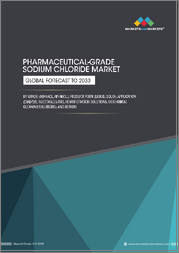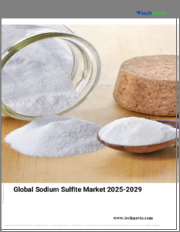
|
시장보고서
상품코드
1661148
세계의 염화나트륨 시장 보고서 : 공급원별, 최종 용도별, 지역별(2025-2033년)Sodium Chloride Market Report by Source (Sea Water, Rock Salt, and Others), End-Use (Chemical Industry, Food Grade Salt, Road De-icing, and Others), and Region 2025-2033 |
||||||
염화나트륨 시장 세계 시장 규모는 2024년 297억 달러에 달했습니다. 향후 IMARC Group은 2033년에는 346억 달러에 달할 것으로 예상하며, 2025-2033년 연평균 성장률(CAGR)은 1.81%를 나타낼 것으로 예측했습니다.
화학식 NaCl로 표현되는 염화나트륨은 나트륨 이온과 염화물 이온이 1:1의 비율로 존재하는 이온 화합물입니다. 일반적으로 식염, 식용 소금, 천일염이라고도 불리는 염화나트륨은 물에 잘 녹는다. 백색의 결정성 고체이며 구토제 및 난연제로 작용합니다. 또한 인체 체액의 전해질 균형을 유지하는 데 필수적입니다. 또한 영양소의 흡수와 운반, 혈압과 체액의 적절한 균형 유지, 신경 신호 전달, 근육의 수축과 이완에도 NaCl이 필요합니다. 최근 사료, 물 및 폐기물 처리, 섬유, 의약품 등 다양한 분야에서 NaCl의 사용량이 크게 증가하고 있습니다. 또한 북미와 유럽에서는 폭설 시 도로와 고속도로의 제빙에도 사용되고 있습니다.
염화나트륨 시장 동향 :
다양한 산업에서 염화나트륨의 용도가 증가함에 따라 시장 성장을 가속하는 주요 요인입니다. 식품 분야에서 염화나트륨은 주로 조미료, 착색제, 육류 경화, 생선 보존에 사용됩니다. 풍미를 높이고, 식품을 보존하고, 부패를 방지하고, 즉시 먹을 수 있는 고기와 치즈를 안전하게 먹을 수 있습니다. 소금은 또한 소금, 소금에 절인 양배추, 피클, 케피어 등 식품의 발효 과정에도 사용됩니다. 이 외에도 카테터 세척용 주사나 점적, 콘택트렌즈 등의 세척에도 이용되며, NaCl은 주로 가성소다, 염소산나트륨, 염화암모늄, 탄산수소나트륨의 제조에 사용되는 화학공업에 필수적인 화학물질 중 하나입니다. 또한, 염화나트륨은 많은 산업 공정 및 연수화 목적의 원료로 대량으로 사용되고 있습니다. 이러한 요인들은 가까운 미래에 시장 성장에 긍정적인 추진력을 제공할 것으로 예상됩니다.
본 보고서에서 다룬 주요 질문
- 2024년 세계 염화나트륨 시장 규모는?
- 2025-2033년 세계 염화나트륨 시장의 예상 성장률은?
- 세계 염화나트륨 시장을 이끄는 주요 요인은?
- 코로나19가 세계 염화나트륨 시장에 미치는 영향은?
- 세계 염화나트륨 시장의 출처별 시장 분석은?
- 세계 염화나트륨 시장의 최종 용도별 분류는?
- 염화나트륨 시장의 세계 주요 지역은?
- 세계 염화나트륨 시장의 주요 기업은?
목차
제1장 서문
제2장 조사 범위와 조사 방법
- 조사 목적
- 이해관계자
- 데이터 소스
- 1차 정보
- 2차 정보
- 시장 추정
- 보텀업 접근
- 톱다운 접근
- 조사 방법
제3장 주요 요약
제4장 서론
- 개요
- 물리적 및 화학적 성질
- 주요 업계 동향
제5장 세계의 염화나트륨 산업
- 시장 개요
- 시장 실적
- 수량 동향
- 매출 동향
- COVID-19의 영향
- 가격 분석
- 주요 가격 지표
- 가격 구조
- 가격 동향
- 시장 분석 : 소스별
- 시장 분석 : 최종 용도별
- 시장 분석 : 지역별
- 시장 예측
- SWOT 분석
- 개요
- 강점
- 약점
- 기회
- 위협
- 밸류체인 분석
- 개요
- 원료 탐사
- 채굴과 추출
- 염화나트륨 제조업체
- 유통업체
- 수출업체
- 최종사용자
- 마진 분석
- Porter의 Five Forces 분석
- 개요
- 바이어의 교섭력
- 공급 기업의 교섭력
- 경쟁 정도
- 신규 진출업체의 위협
- 대체품의 위협
- 무역 데이터
- 수입
- 수출
- 제조업체의 중요 성공 요인
제6장 시장 분석 : 공급원별
- 해수
- 암염
- 기타
제7장 주요 지역 실적
- 아시아
- 유럽
- 북미
- 남미 및 중미
- 기타
제8장 시장 분석 : 최종 용도별
- 화학 산업
- 식품 등급 소금
- 도로 동결 방지
- 기타
제9장 경쟁 구도
- 시장 구조
- 주요 기업의 생산능력
- 주요 기업 개요
제10장 염화나트륨 제조 공정
- 제품 개요
- 관여하는 화학반응
- 세부 프로세스 플로우
- 태양 증발
- 인공 증발
- 다양한 유닛 조작이 관여
- 원재료 요건
- 물질 수지와 원료 전환율
- 해수로부터(태양열 증발법)
- 암염으로부터(진공 증발법)
제11장 염화나트륨 제조 : 관련 주요 기계
- 필요 장비
- 장비 가격
The global sodium chloride market size reached USD 29.7 Billion in 2024. Looking forward, IMARC Group expects the market to reach USD 34.6 Billion by 2033, exhibiting a growth rate (CAGR) of 1.81% during 2025-2033.
Sodium chloride, with the chemical formula NaCl, is an ionic compound representing a 1:1 ratio of sodium and chloride ions. Also commonly referred to as salt, table salt or common salt, sodium chloride is readily soluble in water. It appears as a white crystalline solid and acts as an emetic and a flame retardant. It is also essential in maintaining the electrolyte balance of fluids in a person's body. Moreover, the body requires NaCl to absorb and transport nutrients, maintain blood pressure levels and the right balance of fluid, transmit nerve signals, and contract and relax muscles. In recent years, there has been a significant rise in the usage of NaCl in various sectors such as animal feed, water and waste treatment, textiles and pharmaceuticals. It is also used to de-ice the streets and highways during heavy snowfall in the North American and European regions.
Sodium Chloride Market Trends:
The increasing applications of sodium chloride in diverse industries represent the primary factor bolstering the market growth. In the food sector, NaCl is mainly used for seasoning, coloring, curing meats and preserving fish. It helps to enhance the flavor, preserve foods, prevent spoilage and keep ready-to-eat meats and cheeses safe to eat. Salt is also used in the fermenting process for foods like sauerkraut, pickles and kefir. Besides this, it is utilized in catheter flush injections or intravenous infusions and for cleaning objects such as contact lenses. NaCl is one of the essential chemicals used in the chemical industry, mainly for manufacturing caustic soda, sodium chlorite, ammonium chloride and sodium bicarbonate. In addition, a large quantity of sodium chloride is employed as feedstock in many industrial processes and for water softening purposes. These factors are expected to provide a positive thrust to the market growth in the near future.
Key Market Segmentation:
Breakup by Source:
- Sea Water
- Rock Salt
- Others
Breakup by End-Use:
- Chemical Industry
- Food Grade Salt
- Road De-icing
- Others
Regional insights:
- Asia
- Europe
- North America
- South and Central America
- Others
Competitive Landscape:
The competitive landscape of the market has been analyzed, with some of the key players being K+S Group, China National Salt Industry Group (CNSIG), Compass Minerals International, Inc, Cargill Corporation and Dampier Salt Limited (DSL).
The essential aspects of the global sodium chloride market evaluated in the report include:
- Market trends
- Major regions
- Impact of COVID-19
- Key end uses
- Key manufacturers
- Price trends
- Raw material requirements
- Chemical reactions involved in the manufacturing process
- Major importers and exporters
- Value chain analysis
- Machinery Requirements
Key Questions Answered in This Report
- 1.What was the size of the global sodium chloride market in 2024?
- 2.What is the expected growth rate of the global sodium chloride market during 2025-2033?
- 3.What are the key factors driving the global sodium chloride market?
- 4.What has been the impact of COVID-19 on the global sodium chloride market?
- 5.What is the breakup of the global sodium chloride market based on the source?
- 6.What is the breakup of the global sodium chloride market based on the end-use?
- 7.What are the key regions in the global sodium chloride market?
- 8.Who are the key players/companies in the global sodium chloride market?
Table of Contents
1 Preface
2 Scope and Methodology
- 2.1 Objectives of the Study
- 2.2 Stakeholders
- 2.3 Data Sources
- 2.3.1 Primary Sources
- 2.3.2 Secondary Sources
- 2.4 Market Estimation
- 2.4.1 Bottom-Up Approach
- 2.4.2 Top-Down Approach
- 2.5 Forecasting Methodology
3 Executive Summary
4 Introduction
- 4.1 Overview
- 4.2 Physical and Chemical Properties
- 4.3 Key Industry Trends
5 Global Sodium Chloride Industry
- 5.1 Market Overview
- 5.2 Market Performance
- 5.2.1 Volume Trends
- 5.2.2 Value Trends
- 5.3 Impact of COVID-19
- 5.4 Price Analysis
- 5.4.1 Key Price Indicators
- 5.4.2 Price Structure
- 5.4.3 Price Trends
- 5.5 Market Breakup by Source
- 5.6 Market Breakup by End-Use
- 5.7 Market Breakup by Region
- 5.8 Market Forecast
- 5.9 SWOT Analysis
- 5.9.1 Overview
- 5.9.2 Strengths
- 5.9.3 Weaknesses
- 5.9.4 Opportunities
- 5.9.5 Threats
- 5.10 Value Chain Analysis
- 5.10.1 Overview
- 5.10.2 Feedstock Exploration
- 5.10.3 Mining and Extraction
- 5.10.4 Sodium Chloride Manufacturers
- 5.10.5 Distributors
- 5.10.6 Exporters
- 5.10.7 End-Users
- 5.11 Margin Analysis
- 5.12 Porter's Five Forces Analysis
- 5.12.1 Overview
- 5.12.2 Bargaining Power of Buyers
- 5.12.3 Bargaining Power of Suppliers
- 5.12.4 Degree of Rivalry
- 5.12.5 Threat of New Entrants
- 5.12.6 Threat of Substitutes
- 5.13 Trade Data
- 5.13.1 Imports
- 5.13.2 Exports
- 5.14 Key Success Factors for Manufacturers
6 Market Breakup by Source
- 6.1 Sea Water
- 6.1.1 Market Trends
- 6.1.2 Market Forecast
- 6.2 Rock Salt
- 6.2.1 Market Trends
- 6.2.2 Market Forecast
- 6.3 Others
- 6.3.1 Market Trends
- 6.3.2 Market Forecast
7 Performance of Key Regions
- 7.1 Asia
- 7.1.1 Market Trends
- 7.1.2 Market Forecast
- 7.2 Europe
- 7.2.1 Market Trends
- 7.2.2 Market Forecast
- 7.3 North America
- 7.3.1 Market Trends
- 7.3.2 Market Forecast
- 7.4 South and Central America
- 7.4.1 Market Trends
- 7.4.2 Market Forecast
- 7.5 Others
- 7.5.1 Market Trends
- 7.5.2 Market Forecast
8 Market Breakup by End-Use
- 8.1 Chemical Industry
- 8.1.1 Market Trends
- 8.1.2 Market Forecast
- 8.2 Food Grade Salt
- 8.2.1 Market Trends
- 8.2.2 Market Forecast
- 8.3 Road De-icing
- 8.3.1 Market Trends
- 8.3.2 Market Forecast
- 8.4 Others
- 8.4.1 Market Trends
- 8.4.2 Market Forecast
9 Competitive Landscape
- 9.1 Market Structure
- 9.2 Production Capacities of Key Players
- 9.3 Key Player Profiles
10 Sodium Chloride Manufacturing Process
- 10.1 Product Overview
- 10.2 Chemical Reactions Involved
- 10.3 Detailed Process Flow
- 10.3.1 Solar Evaporation:
- 10.3.2 Artificial Evaporation
- 10.3.3 Various Unit Operations Involved
- 10.4 Raw Material Requirements
- 10.5 Mass Balance and Feedstock Conversion Rate
- 10.5.1 From Sea Brine (Solar Evaporation Method)
- 10.5.2 From Rock Salt (Vacuum Evaporation Method)
11 Sodium Chloride Manufacturing: Major Machinery Involved
- 11.1 Equipment Required
- 11.2 Prices of Equipment



















